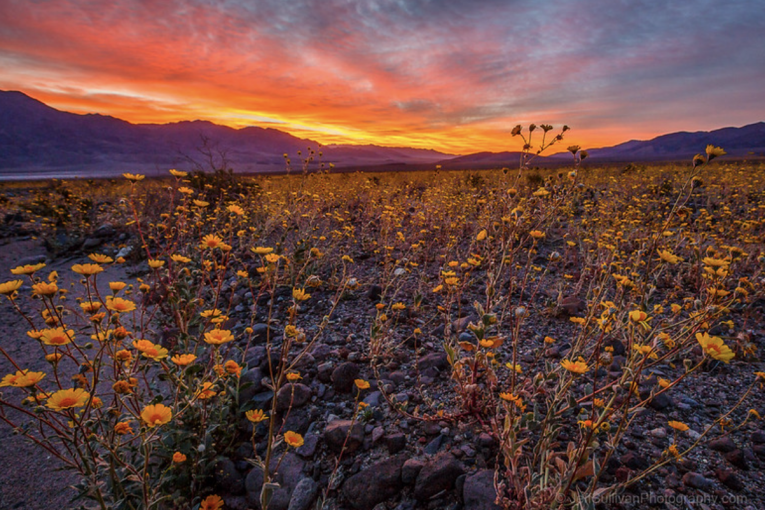
![]()
By Milo Feldman
By now, we’ve all heard news of the California “super bloom:” the handful-of-times-in-a-lifetime event when all of the dormant seeds on California’s rolling hills bloom after a wet winter. Or, if you’re lucky, you’ve driven out of Davis and seen it for yourself! Or, if you’re a NASA satellite in space, you’ve glimpsed yellow, purple, and orange swaths of color surrounding very regimented squares of green and beige farmland.
Needless to say, there is potential to experience a very beautiful spring, specifically in Northern California. For many students especially, this may be the first or only time they will be able to see the super bloom — an event that happens in California every ten years or so. The conditions to cause a super bloom are quite exceptional.
In an article written by Malia Reiss for UC Davis science news, Plant Sciences professor Jennifer Funk explained how it requires an unusually wet winter preceded by a few years of dry conditions. In a dry season, the annual wildflowers’ seeds do not receive enough water to germinate, so their seeds can accumulate and remain dormant underground.
During a winter that exceeds average precipitation levels like this past season, seeds that accumulated after multiple dry seasons can germinate and bloom all at once, covering the normally grassy or barren land with lush blooms of orange California poppies (aptly the state flower), purple lupines and western blue-eyed grass, blue dicks, and yellow fiddlenecks, depending on where you visit.
This spring is beautiful, and it makes it very easy to forget just how devastating the drought has been for agriculture and community health in previous years. It makes it easy to forget that the only reason this happened is because of destructive rainfalls this winter.
Although these super blooms are not unprecedented, it is easy to think they are “normal.”
On April 19th, my Gender, Science & Social Justice class had a guest lecturer, Professor Akua Banful, who, before coming to Davis, worked at the Climate Museum in New York City. In her lecture, she offered a new perspective on the way in which we as individuals can contribute to positive action for climate change efforts. Even before thinking about signing pledges, biking or using public transport, recycling, or becoming vegetarian, first, we must begin thinking of ourselves as individuals with climate stories.
The readings and themes of the previous class discussion largely centered around the way in which climate change is sort of deluded (see Amritav Ghoshe’s “The Great Derangement”) in the minds of the masses, and that is reflected in the way in which climate change is depicted in literature and media.
It’s always in the sci-fi/dystopian genre, depicted as some distant future world facing disaster or a post-climate-apocalypse ravaged world. Climate change is rarely included in realistic fiction as a part of the normal backdrop of everyday life. Somehow, most of us still don’t look around and see the frequent natural disasters, the hotter-than-average summers, or wetter-than-average winters as a part of climate change, especially if we see the consequences of climate change as a feat of science fiction in literature and movies.
Perhaps we know from school and National Geography headlines that the disasters in the news are a part of climate change. But on the normal day-to-day, or when we are reflecting on our lives, most of us don’t see ourselves as affected by climate change. Partially because of the way climate change is depicted in our literature and media, we can’t see ourselves as directly a part of it. We read articles about climate-related impacts on people in other states, on other continents with a very different life than us, so climate change is still deluded in our minds as being other-worldly, or distant.
But if we start talking about climate change, and sharing our climate stories, fears, anxieties, and ideas, it closes the distance between our reality and climate change, and hopefully allows us to feel a greater collective responsibility. Professor Banful shared a work of the Climate Museum that demonstrated this principle.
In the art installation Low Relief for High Water, Gabriella Salazar took paper casts of the windows in her childhood apartment that she now lives in as an adult with her own family, in a part of the city that is susceptible to climate-related floods. In the installation set in Washington Square Park on October 10, 2021, she and her team put the casts up to create four walls — a symbolic representation of her home. Passerbys were allowed “into” her home, and given a piece of it when they leave.
The purpose of the art piece is generally to get people to have an open conversation about climate change and build a sense of collective responsibility. By taking casts of her own home, Salazar complicated the idea of a “refuge” or “safe space.”
Not only is the paper of the home water soluble, drooping throughout the rainy installation day as seen in the short film, but it is being given away piece by piece, representing the susceptibility of her safe space and the instability of the concept of refuge. By taking casts of her home, and giving pieces of it away, she is showing the participants that climate change is personal: it affects you even if it feels distant or dystopian. That distance is a mirage or false wall.
When we operate with this distance surrounding climate change it makes it impossible to have an active role in climate mitigation efforts. By taking the opportunity to reflect on events like the California super bloom, we need to see ourselves as affected — as people with personal climate stories — in order to care enough to take action.
IMAGE:
“Death Valley ‘Super Bloom’ Sunrise” by Jeffrey Sullivan https://www.flickr.com/photos/jeffreysullivan/25755518805